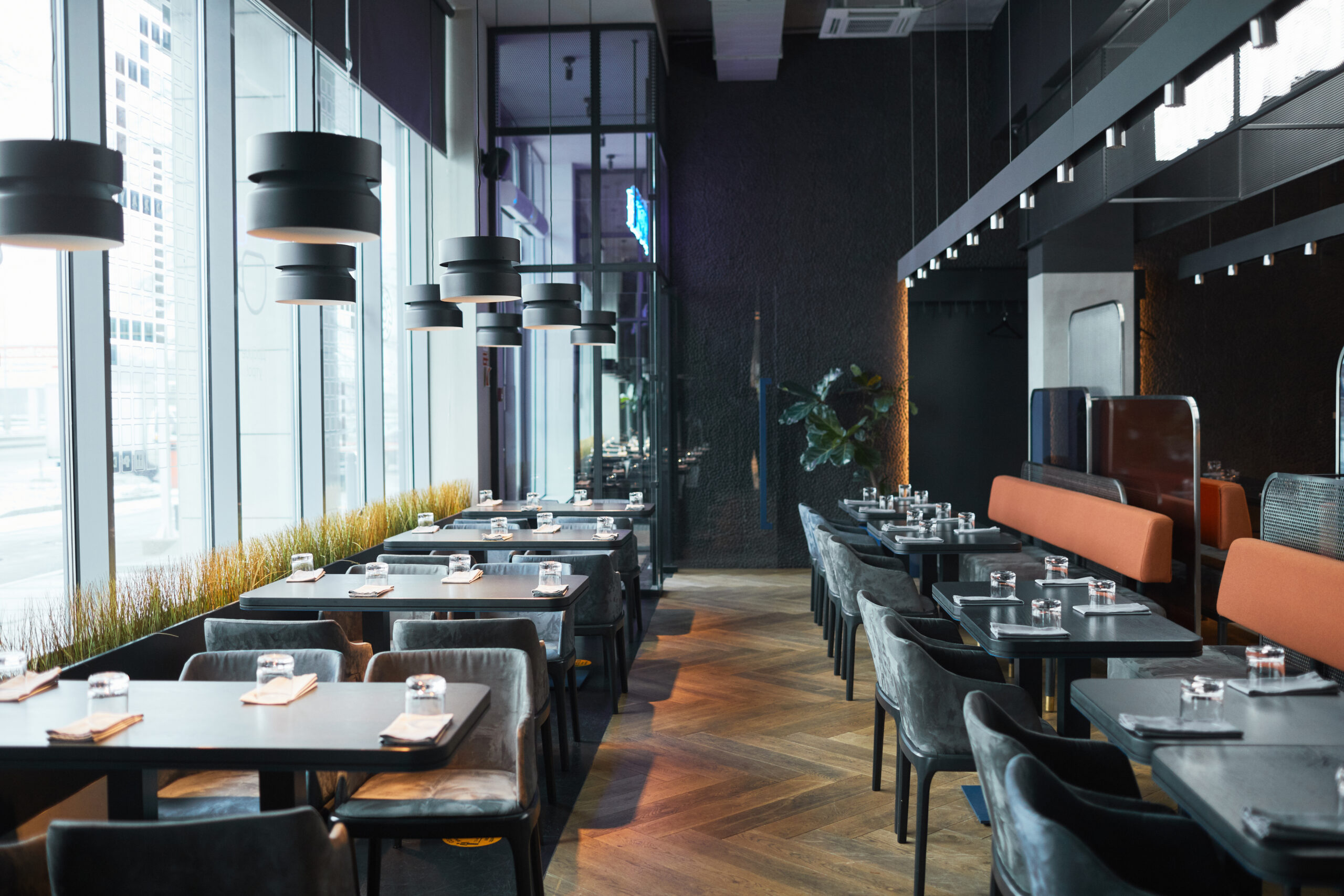Restaurant interior design is regarded as one of the most important aspects when it comes to kickstarting an establishment and aiming for success. Below are some reasons why restauranteurs need to focus on interior design.
The interior design of a restaurant plays a huge role in increasing customer experience and comfort, adding to the success of the venue even beyond its menu. It is the ambiance, seating, lighting, and acoustics that create how customers will feel when they enter.
A well-designed space will ensure diners feel relaxed and engaged, and therefore want to linger and return. Comfortable seating with adequate spacing creates an atmosphere of pleasurable dining that prevents overcrowding and noise disturbance. The thoughtful choices of lighting for the setting desired, whether intimate with warm ambient lighting or bright and natural lighting for casual eateries, really set the tone and affect the dining behaviour.
Acoustics are another thing — sound-absorbing materials or strategic layout can minimise excess noise and ensure pleasant conversations. Temperature control and ventilation also help maintain comfort for customers to savour their meal without feeling overly hot or cold. Besides physical comfort, aesthetics and decor add to the dining experience. Aesthetically pleasing ambience, thematic consistency, and colour consistency build an inviting environment where one is able to more enjoyably eat and remember meals.
If people are comfortable in a restaurant, they will also stay longer and order more while recommending the restaurant to others. This emotional bond creates customer loyalty and repeat business. Ultimately, a restaurant that has comfort through well-thought design upgrades not only the dining experience but also promotes success through increased customer satisfaction, encourages positive reviews, and differentiates the establishment from competitors. Investment in interior design is investment in long-term business growth.

Restaurant interior design plays an indispensable role in building brand identity: making the venue of dining easily recognisable and unforgettable. A restaurant’s ambiance can tell more than just its concept, values, and target audience beyond serving great food.
A luxurious, clean-cut feel for a fine dining experience, rustic and cozy for the farm-to-table restaurant, or bright and lively for the interior of a fast-casual establishment-whatever design one wants to stand for. Thoughtfully selected colour palettes combined with materials and decor items give the venue a cohesive look that separates it from its competition. From the layout and furniture to even the music, every detail creates a multi-sensory experience that speaks to your brand’s personality. When done well, interior design fosters an emotional bond with your customers, leading to loyalty and repeat visits.
A unique and pretty design makes the venue more “Instagrammable” to improve organic marketing through social shares and word-of-mouth promotion. Lighting, signage, and creative elements further cement branding to make sure customers create a specific atmosphere related to the identity of the restaurant. This will then be carried through, consistent in repetition both in physical space and marketing, to further engender customer perceptions and build trust.
Well-defined interior design not only attracts the intended demographic but also shapes the way people feel about the dining experience. And that is how, in a competitive food industry with options galore, a strong brand identity created via interior design can be the icing on the cake, which keeps the guests coming, fuelling success beyond the menu.
A well-designed restaurant interior is much more than aesthetics; it is about the optimisation of functionality and flow that ensures smoother operations, enhancing the dining experience. Efficient space planning enhances staff productivity and customer satisfaction.
For instance, a tactically engineered layout minimises congestion, allowing waitstaff to glide effortlessly between tables, kitchen, and service areas. Wide and clear walkways prevent bottlenecks, reducing wait times and enhancing service speed. The kitchen, bar, and serving stations are to be placed with care for the efficiency of workflow, keeping up the rhythmic flow of food delivery. Further, the seating arrangement must strike a balance between comfort and occupancy – a well-spaced table offers privacy with the facility for easy mobility.
Thoughtful zoning, including a waiting area, private dining area, open seating among others, begets a clear structured environment in dining. Accompanied by integrations of technology, such as self-ordering kiosks or digital table management systems, these further smooth operations and heighten customer experience. The acoustic design also plays into functionality: proper soundproofing keeps the noise level manageable so that disruption in conversations will not take place, and it keeps the atmosphere pleasant.
Yet another important aspect that should be included is lighting– it should be bright enough to enable efficiency among staff and inviting to diners. Optically, the functionality and flow inside restaurants directly fuel business success from the menu – an environment in which customers have a seamless, stress-free experience and where the staff can give their best. This synergy leads to higher customer retention, good reviews, and, finally, increased profitability.

The restaurant interior design may play a powerful role in customer behaviour, influencing how long customers linger, what they order, and even how much money they will spend. Colours, lighting, seating, and ambiance can influence diners at the subliminal level.
Warm colours — red, orange, and yellow-drive appetite and energise; thus, fast-casual and high-turnover restaurants especially favour these. On the other hand, cooler tones, such as blue and green, make customers relaxed and linger on, which is suitable for high-end restaurants. Lighting also plays an important role — a bright and well-lit place is energetic and social, while a dimly lit one is intimate and slow-paced. Seating arrangements further dictate customer flow, with comfortable, spacious seating encouraging extended stays while compact layouts maximise turnover rates.
@theritzlondon Inside The Ritz kitchen. #TheRitz #TheRitzLondon #Michelin #TopUKRestaurants #LondonRestaurants
Moreover, background music and fragrance can be used to subtly enhance the dining experience – upbeat music encourages quick dining while soft, slow tunes encourage lingering. Even materials used, like wood for warmth or metal and glass for a modern feel, influence customer perception of the brand. Well-designed spaces not only enhance the dining experience but also drive purchasing behaviour.
These can be ideas like having a very enticing dessert display or a visible kitchen. Such aspects unconsciously encourage customers to make orders. When done strategically, restaurant interior design aligns with business goals: increasing table turnover, boosting order value, or fostering brand loyalty. By leveraging subconscious cues, restaurants can craft an environment that subtly dictates customer decisions and fuels success beyond just the menu.
A restaurant interior itself says a lot and is a reason for significantly encouraging social media engagement, boosting its success beyond the menu. In the modern digital era, food lovers simply love sharing their dine-out experiences through social media, and an aesthetically pleasing space amplifies the chances that customers will post pictures and tag the restaurant.
Unique design elements, such as Instagrammable walls, neon signs with catchy phrases, artistic plating stations, and aesthetically pleasing furniture, create a picture-perfect setting that attracts social media users. The more customers share photos of a restaurant, the greater its online visibility, leading to organic marketing and brand exposure. A strong social media presence not only brings in new visitors but also cements the status of restaurants as trendy or must-visit spots.
Furthermore, well-lit areas with natural or warm lighting elevate the quality of food and interior shots, making it easier for diners to take amazing shots. Restaurants that add interactive elements to their space, such as flower walls, themed seating areas, or creative murals, further increase engagement by encouraging user-generated content. This form of free publicity can result in viral trends, influencer visits, and increased foot traffic-driving revenue.
More than that, interior design thematic to a restaurant or its brand story provides good storytelling reason for customers to connect with the space and share experiences. In an industry replete with competition, restaurants that implement designs to appeal to social media gain a huge advantage by digital word-of-mouth marketing.

Need help with interior design? I-dzine is your answer to it. We are experts in transforming space from virtual to reality. Our expertise in renovation design, oversight, and management ensures that your property is well-designed. We relentlessly focused on delivering meticulously created, beautiful, functional designs.